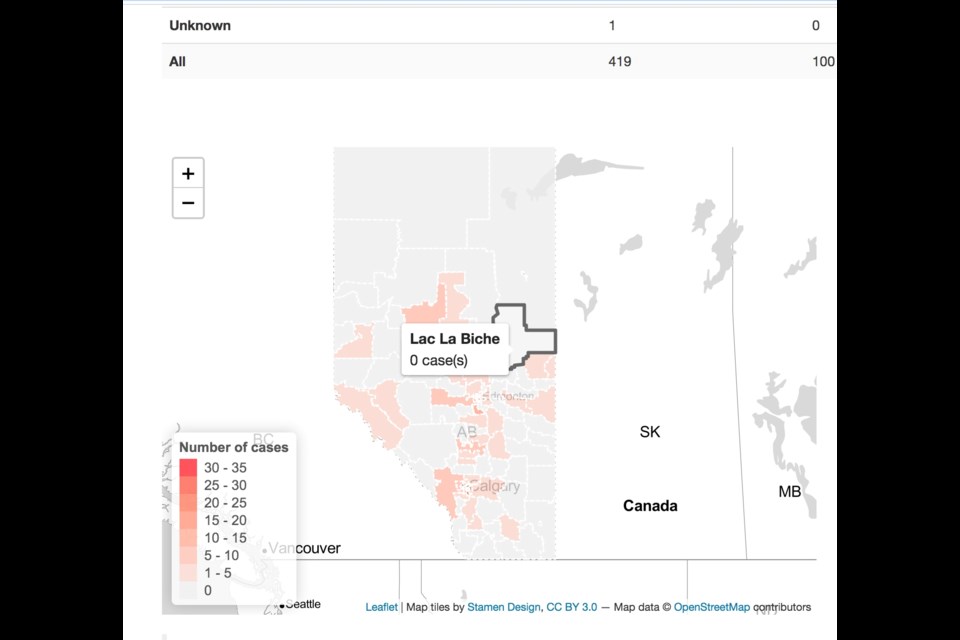It's not the adventurous and colourful one that Dora has in her backpack, but for the last two and a half months virtual explorers looking for COVID information have have been unpacking a lot of information from the Alberta government's COVID-19 map. And last week, the map on the government's COVID-19 pandemic page got a new splash of colour and a new regional ranking of confirmed cases that had some Lac La Biche region residents thinking their community had its first case of the pandemic.
For 62 days, the province's online COVID map has been an important part of the information process. And for 62 days, the Lac La Biche region has recorded zero confirmed cases of the respiratory pandemic that has infected more than 4.4 million people worldwide.
The newest version of the map, updated last Thursday, included a new colour scheme that ranges from pale yellow for the least activity to red for the most severe, along with an option to see the map in either municipal boundaries or regional puzzle pieces. It also has a new case numbering system.
The least amount of cases — the pale yellow colour for the region — is now attached to a number of cases ranging from "0-1".
That change in numbering had some residents thinking the community now has a case. According to officials with Alberta Health, however, the lowest on the colour chart level still indicates zero active cases. In the map's sliding scale of severity, the next level (an orangy-yellow) ranges from "1-4 cases" then "4-34" and (from last Saturday's data) the top level is a range from "34 to 3623."
Alberta Health's assistant manager of communications Tom McMillan said the map has seen several updates since it was introduced.
"We continue to refine and update the information we share online, with new features added almost every week.," he told the POST last Thursday night.
In the first days of the pandemic, the map was a simple jigsaw puzzle, divided into about 60 regional pieces. Each piece was updated daily with any confirmed cases. The first map version was not interactive and the black and white graphic gave no further information. But as the weeks went on, the map — and a data inventory of interactive and 'geospatial' details — expanded. Colour was added to the map, with grey being zero cases and a range of red shades indicating escalating severity. A hovering mouse over any region on the map would now show not only the number of cases, but how many were active, how many had recovered, and how many had resulted in deaths. Drop-down categories on the online pages to compliment the map now include a breakdown of cases by age, region, date and the severity.
The latest version, McMillan said, was upgraded to make the information easier to digest.
"We made minor changes to colour and scale make the map easier to see (and) navigate for the public, and to reflect the number of cases that have occurred across the province," he said.
As of last Saturday, the Lac La Biche region remained with zero cases. It is one of 22 regions on a map divided into about 70 pieces still reporting zero cases.
"Lac La Biche is still doing very well," McMillan said.
Across the province as of Saturday, there have been 6,587 confirmed cases of COVID-19, with 1,084 cases listed as currently active. The virus has been blamed for the deaths of 126 people in Alberta.
In Saturday's update, government officials have increased the amount of people allowed to gather at outdoor events to 50 from the previous limit of 15. Indoor events are still limited under Alberta Public Health Act protocols to 15. Provincials officials also began their second phase of their relaunch plan on Thursday, lifting most restrictions on all provincial businesses.



